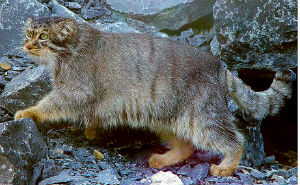Domestic Cat × Pallas's Cat
Felis catus × Felis manul
Mammalian Hybrids
EUGENE M. MCCARTHY, PHD GENETICS, ΦΒΚ

|
|
Pallas's Cat (Felis manul ) |

|
|
Peter Simon Pallas (1741-1811) |
These cats come into contact in western and central Asia. Pallas’s cats are named for Peter Simon Pallas (1741-1811), the German naturalist who first described them to science. Darwin (1868, vol. 1, p. 45) says
Though the two are considered distinct breeds today, in the 19th century Persians and Angoras were generally regarded as belonging to the same breed. Thus, in 1903, Frances Simpson wrote in her book The Book of the Cat,
The name Persian cat may be significant, given that F. manul does occur in Persia (modern Iran), and Pallas’s cats do have fluffy hair like a Persian cat, which suits them to the cold, high-altitude environments in which they are typically found. But Pallas actually said not just that he thought the Persian is derived from this cross, but also provided the additional bit of information that they “easily mate” (or, perhaps, since the original Latin coëat is ambiguous “easily unite to produce offspring”). The passage in question appears in Pallas’s Zoogeographia Russo-Asiatica (1831, p. 23):
A list of cat crosses
The following is a list of reported cat crosses. Some of these crosses are much better documented than others (as indicated by the reliability arrow). Indeed, some might seem completely impossible. But all have been reported at least once. The links below are to separate articles. Additional crosses, not listed here, are covered on the cat hybrids page.
|
|
By the same author: Handbook of Avian Hybrids of the World, Oxford University Press (2006).
Most shared on Macroevolution.net:
Human Origins: Are we hybrids?
On the Origins of New Forms of Life
Mammalian Hybrids
Cat-rabbit Hybrids: Fact or fiction?
Famous Biologists
Dog-cow Hybrids
Georges Cuvier: A Biography
Prothero: A Rebuttal
Branches of Biology
Dog-fox Hybrids